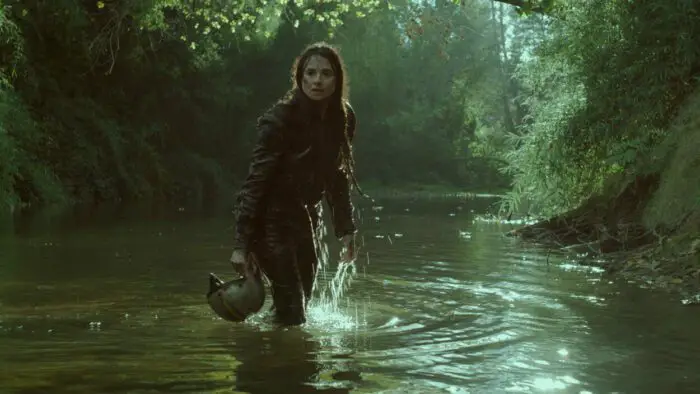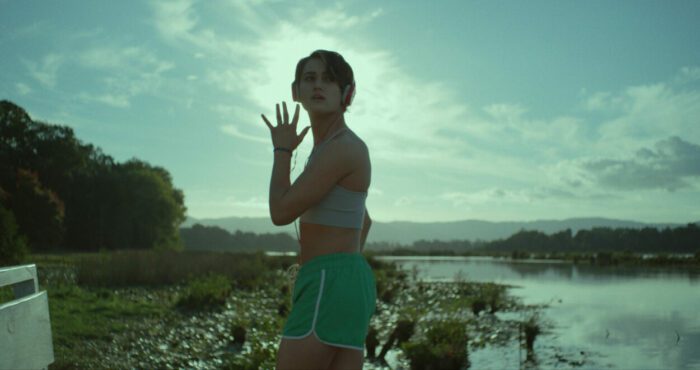The Cow Who Sang a Song Into the Future, the debut feature film from Chile-born, U.S.-educated Francisca Alegría, can at times be as vexing as its characters’ bewilderment when confronting the dead among the living. Yet its lyricality and ambition make for a curiously poignant hybrid of a film. Part environmentalist parable, part anti-industrialist espionage, part Queer familial melodrama spun together into a delicate balance of troubling fact and magical realism.
The film begins, if film beginnings import with them some sense of what’s to come in terms of story and style, with a chorus of nature’s creatures in dire distress. In a river in the south of Chile, schools of fish are dying in droves, flailing and gasping on the banks due to the increased pollution from a nearby pulp factory. An ethereal chorus of their voices floats through the air, singing their deathsong, when a figure rises mysteriously from the deep: her silver motorbike helmet rising first, she resembles the fish but bubbles up to the surface gasping for air and desperate for the touch of earth. Long deceased, she is a woman named Magdalena (Mia Maestro), whose encounters with her conflicted family will open up old wounds and expose family secrets.

That Magdalena rises from the dead to haunt the living parallels the lives and deaths of the country’s animals as they suffer the effects of an ecosystem plagued by disaster. Bees die from the spraying of pesticides, cows from a poisoned grazing field. But that they die does not mean they lack a voice: in Alegria’s world they sing a literal Greek chorus of their woes, warning humans who might have the foresight to listen to reconsider their impact on the animal world around them. It might require some suspension of disbelief to accept the sung words of a bovine chorus to engage the film’s environmentalist themes, but Alegría constructs her fictional film world with a deft touch and imaginative vision. The film’s title—The Cow Who Sang a Song Into the Future—is surprisingly literal for a film so unabashedly figurative.

So long dead her own fully-grown daughter Cecilia (Leonor Varela) now resembles her—being approximately the same age and body shape with some similar features—Magdalena makes her way back to the dairy farm that was her home and the family she once knew. Her widowed husband Enrique (Alfredo Castro) is shocked to his core. Her now-adult son Bernardo (Marcial Tagle) finds, finally, his courage. And Cecilia’s children seem delighted, if in very different ways, by Magdalena’s haunting presence.
Magdalena, meanwhile, now a corporeal spirit, finds her more primal urges a comfort: she indulges food, laughter, comfort, sex, dance, more alive in some ways than ever, more attuned to her surroundings. It’s as if in death she has found life. Her granddaughter Tomás (Enzo Ferrada—a young male actor playing the transgender teen), having been forced by her mother to present as male, finds in Magdalena an especially kindred spirit, one whose newfound freedoms present the teen trans girl a path to a freedom she’s never felt in her cloistered, closeted home.

The film’s plot, though rich in its lyricality and characterizations, feels a little slim—perhaps fabular is a better word—even for its 90-minute runtime. The pace is more a slow saunter than a quick gait, and never really changes even as the conflicts reach their climax. At one point, two of the principals ride motorbikes, each in opposite destinations, towards differing goals, glancing briefly in confusion at each other as they pass. You’d be forgiven being similarly disoriented.
But kudos to director Alegría and her stars Maestro and Varela and to her mining this rich vein. Film art need not, as Buñuel and Vigo and others taught us long ago, limit itself to the mundane or the spectacular. Sometimes the most compelling imagery and haunting narratives evolve when those two meet. And in The Cow Who Sang a Song Into the Future, Francisca Alegría has graced us with a contemporary tale of choral creatures and kindred spirits who sing a magically-real song of renewal.
Acclaimed at the Sundance, San Francisco, Seattle, and Frameline film festivals, The Cow Who Sang a Song Into the Future opens on Friday, May 19, at the Quad Cinema in New York City, and on Friday, May 26 at the Laemmle Theaters in Los Angeles, followed by other cities across the country. Chile/France/USA/Germany | 2022 | 93 min | 1:85:1 | Color | In Spanish with English subtitles.



